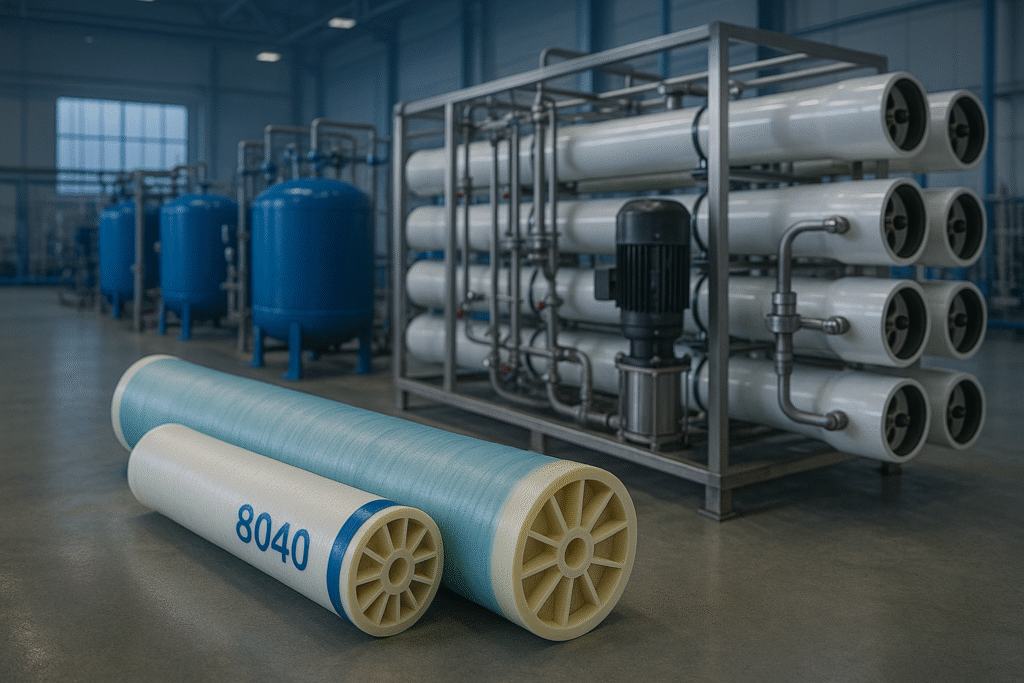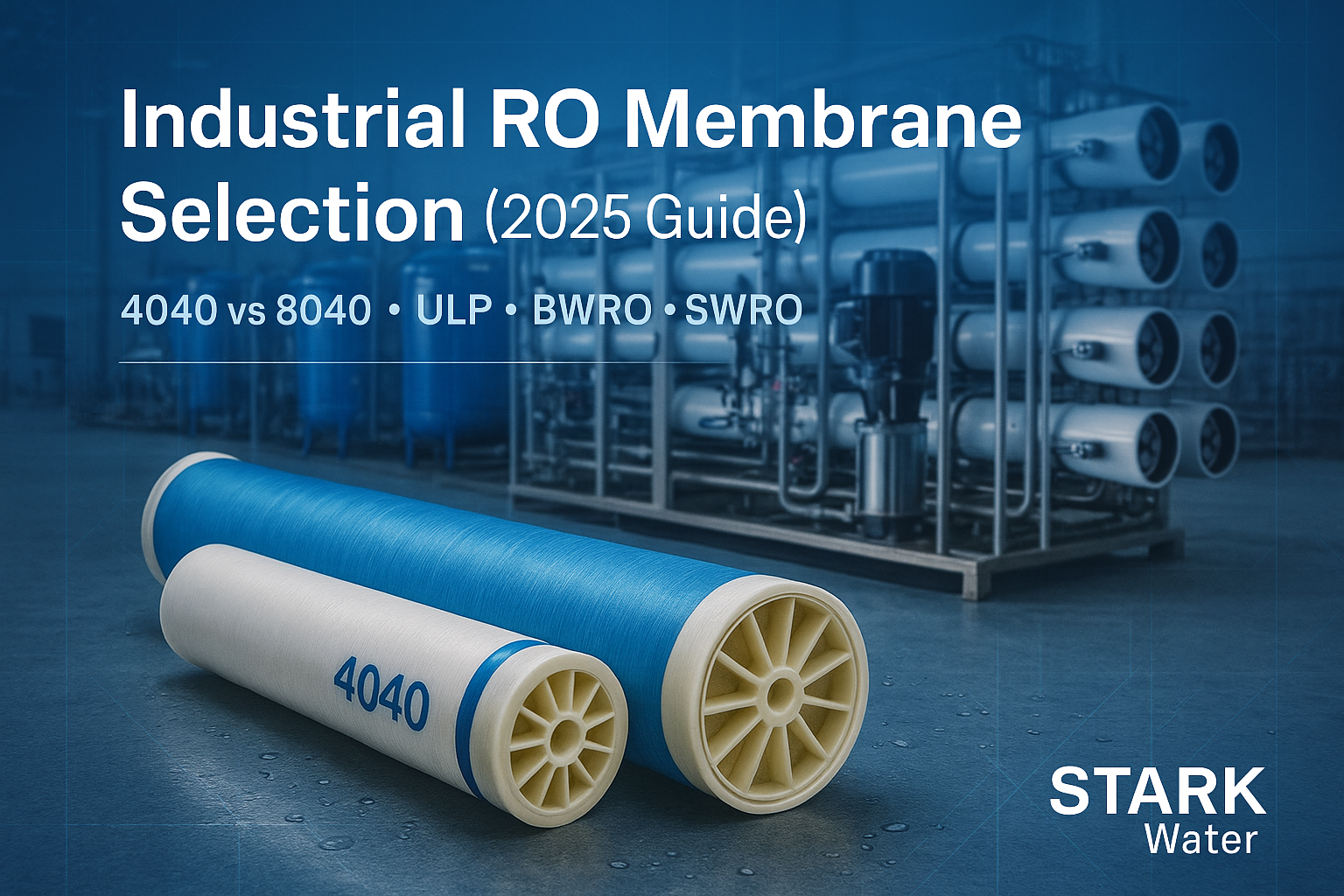TL;DR — Industrial RO membrane selection: choose 4040 for compact skids & pilot lines; 8040 for plant-scale OPEX efficiency. Use ULP when pressure/energy is the bottleneck, BWRO for 1,000–10,000 mg/L brackish feeds, and SWRO for seawater. Keep SDI < 3, remove free chlorine before RO, design recovery in stages (e.g., 70–85% for brackish), and size by allowable flux & ΔP. Need machine-readable datasheets, batch QA, and engineering support? Agua STARK can help.
Why this guide
Industrial buyers are balancing quality, energy, and lead time. This guide gives you a practical, engineer-first framework to select RO membranes—plus procurement checkpoints you can apply immediately to RFQs and factory audits.This industrial RO membrane guide focuses on practical engineering trade-offs.
Industrial RO membrane families at a glance
| Family | Typical Feed TDS | Typical Pressure | Design Notes | Applications |
|---|---|---|---|---|
| ULP (Ultra-Low Pressure) RO | ~500–3,000 mg/L | Lower than BWRO | Energy-saving; watch fouling margin | Groundwater, municipal polishing, reuse |
| BWRO (Brackish Water RO) | ~1,000–10,000 mg/L | Moderate | General-purpose; broad chemical window | Industrial process water, boiler make-up |
| SWRO (Seawater RO) | ~30,000–45,000 mg/L | High | Energy recovery recommended | Seawater desalination, islands, coastal plants |
| NF (Nanofiltration) | Varies | Low–moderate | Partial softening; lower salt rejection | Dye/sugar, partial demin, organics removal |
4040 vs 8040: which one and when
| Parámetro | 4040 Element | 8040 Element |
|---|---|---|
| Typical use | Pilot, small flows, modular skids | Industrial plants, low OPEX targets |
| Housing footprint | Compact; easier retrofits | Larger; better per-m² CapEx |
| Permeate per pressure vessel | Lower | Higher (fewer vessels & valves) |
| Flux stability | Sufficient for small duty | More stable across loading & CIP cycles |
| When to choose | Space-limited, fast delivery, pilot QA | Throughput & energy efficiency prioritized |
When comparing 4040 vs 8040, evaluate industrial RO membrane flux windows at operating temperature.
Industrial RO membrane selection & sizing step
- Characterize feed: TDS/conductivity, temperature, SDI/NTU, hardness, silica, iron/manganese, free chlorine (must be removed before RO).
- Pre-treat: Multimedia/UF, antiscalant dosing, dechlorination (SMBS/C-filters), micron filtration. Aim for SDI < 3.
- Set targets: Permeate quality, recovery (e.g., 70–85% for brackish), maximum ΔP per stage, cleaning philosophy.
- Pick family & format: ULP vs BWRO vs SWRO; 4040 for compact, 8040 for plant scale.
- Select flux window: Respect supplier’s recommended L·m⁻²·h⁻¹ at your temperature; derate for fouling risk.
- Stage & array: 1:1, 2:1, 2:2 etc. Verify recovery per stage and concentrate scaling limits.
Tip: For RFQs, request batch QA (flow/rejection at standard test), element pressure drop, and wet vs dry shipping details.
Illustrative selection example
Goal: 20 m³/h permeate from 2,000 mg/L feed at 25 °C, brackish source. Target recovery 75%.
- Family: BWRO; Format: 8040.
- Design flux: pick within supplier window (illustrative 14–18 L·m⁻²·h⁻¹); multiply by active area to estimate element yield.
- Array: start from 2:1 or 2:2; check stage recoveries vs scaling limits; iterate on vessels-per-stage for ΔP margins.
- Energy: estimate specific energy (kWh/m³) from operating pressure and pump efficiency; consider ERD for high-TDS.
For brackish feeds, an industrial RO membrane often lands at 70–85% recovery per overall design.
Note: numbers above are for method illustration. Use your membrane’s official datasheet values during final design.
Procurement checklist for global buyers
- Datasheets: machine-readable parameters (active area, test pressure/NaCl ppm, pH range, ΔP, cleaning limits).
- Batch QA: factory test report per lot (standardized flow & rejection).
- Certificates: quality system (e.g., ISO 9001) and material compliance where required.
- Packaging & storage: wet vs dry; shelf-life, transport temperature, preservation chemical.
- Lead time & MOQ: clear production calendar, export experience, spares availability.
- After-sales: CIP playbook, troubleshooting response time, multilingual tech support.
Why partner with STARK Water (China)
- Engineering-first: selection support, array checks, and start-up guidance for RO/UF/pretreatment.
- Data you can use: specifications published in HTML tables + downloadable PDFs; JSON-LD for AEO.
- Global delivery: export experience across Latin America, Southeast Asia, the Middle East, and Europe.
- Lifecycle support: cleaning windows, antiscalant pairing, and training materials.
Request a membrane shortlist & sizing check → | View our RO membrane catalog →

Case snapshots
- Beverage line reuse: 2,000 mg/L feed, BWRO-8040, 75% recovery with antiscalant; stable permeate for blending.
- Cooling tower blowdown: variable silica handled via pretreatment + conservative flux; improved cycles of concentration.
- Coastal plant: SWRO with energy recovery; staged CIP plan reduces chemical consumption.
Always request batch QA for the industrial RO membrane lots included in your RFQ
FAQs
- What’s the quick rule for 4040 vs 8040?
- 4040 for compact/low-flow systems; 8040 for plant-scale throughput and lower OPEX.
- How do I keep membranes from fouling?
- Control SDI (<3), remove free chlorine, optimize pretreatment, and operate within recommended flux/ΔP.
- ULP vs BWRO—when to choose ULP?
- When energy or pressure is constrained and feed TDS is moderate. Validate flux margins vs fouling risk.
- What recovery should I target?
- Depends on chemistry. Brackish designs often land around 70–85% in multiple stages; check scaling limits.
- Can STARK Water help with array design?
- Yes—send feed analysis, temperature, target permeate, and footprint. We’ll propose a membrane shortlist and array outline.
- Do you provide batch QA?
- We provide lot-level test data on flow/rejection at standard conditions, plus handling & storage instructions.
Next step: send your water analysis and target flow to stark@stark-water.com for a 24-hour preliminary selection.

